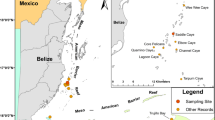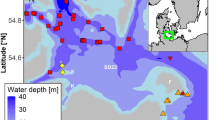Abstract
The pelagic larval phase represents a critical period in the early life history of fishes, since larval growth and development can contribute substantially to patterns of survival, dispersal and connectivity. The microstructure of otoliths was examined to investigate events during the early life history of the bridled monocle bream Scolopsis bilineatus (Nemipteridae) on the Great Barrier Reef. We validated a distinct settlement mark, characterized by a rapid transition from wide to narrow increments. The time fish spent in the plankton (Pelagic Larval Duration; PLD) ranged from 17 to 27 days (mean = 21.3 days), which is similar to many other fish families. Three distinct early life history stages occurred: pre-settlers (larvae), newly settled fish, and settled juveniles. Increment width (a proxy for growth) was sequentially narrower with each life history stage; pre-settlers>newly settled>settled juveniles, and growth was reduced as fish approached and underwent settlement to reef habitats. Evidence is provided for a “search phase”, whereby growth was reduced in the three to four days preceding settlement; this pattern may be indicative of changes in the behaviour of larvae immediately prior to settling. Two manipulative experiments investigated the effects of diet ration on otolith increment widths. Reduced food intake resulted in significantly narrower increment widths, with a possible lag effect of at least six days. Experiment results indicated that increment widths can be a reliable proxy of somatic growth, and results from this study overall highlight the utility of otoliths as a tool for investigating the early life history of fishes.





Similar content being viewed by others
References
Bay LK, Buechler K, Gagliano M, Caley MJ (2006) Intraspecific variation in the pelagic larval duration of tropical reef fishes. J Fish Biol 68:1206–1214. https://doi.org/10.1111/j.1095-8649.2006.01016.x
Bergenius MA, Meekan MG, Robertson RD, MI MC (2002) Larval growth predicts the recruitment success of a coral reef fish. Oecologia 131:521–525. https://doi.org/10.1007/s00442-002-0918-4
Bergenius MAJ, McCormick MI, Meekan MG, Robertson DR (2005) Environmental influences on larval duration, growth and magnitude of settlement of a coral reef fish. Mar Biol 147:291–300. https://doi.org/10.1007/s00227-005-1575-z
Boaden AE, Kingsford MJ (2012) Diel behaviour and trophic ecology of (Nemipteridae). Coral Reefs 31:871–883. https://doi.org/10.1007/s00338-012-0903-2
Boaden AE, Kingsford MJ (2013) Distributions and habitat associations of the bridled monocle bream Scolopsis bilineatus (Nemipteridae): a demographic approach. J Fish Biol 83:618–641
Booth DJ (2002) Distribution changes after settlement in six species of damselfish (Pomacentridae) in one tree island lagoon. Great Barrier Reef Mar Ecol Prog Ser 226:157–164
Brothers EB, Mathews CP, Lasker R (1976) Daily growth increments in otoliths from larval and adult fishes. Fish Bull- NOAA 74:1–8
Brothers EB, Williams DM, Sale PF (1983) Length of larval life in twelve families of fishes at one tree lagoon, great barrier reef, Australia. Mar Biol 76:319–324
Brunton BJ, Booth DJ (2003) Density- and size-dependent mortality of a settling coral-reef damselfish (Bleeker). Oecologia 137:377–384. https://doi.org/10.1007/s00442-003-1377-2
Campana SE (1983) Feeding periodicity and the production of daily growth increments in otoliths of steelhead trout (Salmo gairdneri) and starry flounder (Platichthys stellatus). Can J Zool 61(7):1591-1597
Campana SE (1990) How reliable are growth back-calculations based on otoliths? Can J Fish Aquat Sci 47:2219–2227
Doherty P, Kingsford M, Booth D, Carleton J (1996) Habitat selection before settlement by Pomacentrus coelestis. Mar Fresh Res 47:391–399. https://doi.org/10.1071/mf9960391
Gagliano M, McCormick MI, Meekan MG (2007) Survival against the odds: ontogenetic changes in selective pressure mediate growth-mortality trade-offs in a marine fish. Proc R Soc B Biol Sci 274:1575–1582. https://doi.org/10.1098/rspb.2007.0242
Green B, Begg G, Carlos G (2009) Tropical fish otoliths: information for assessment, management and ecology. Springer Verlag
Grorud-Colvert KA, Sponaugle S (2004) Predation in marine protected areas: preliminary results of the effects on growth and survivorship of newly-settled coral reef fishes. Proceedings of the fifty-fifth annual gulf and Caribbean fisheries institute. Gulf Caribbean Fisheries Inst Gcfi, Ft Pierce
Hall A, Kingsford M (2016) Predators exacerbate competitive interactions and dominance hierarchies between two coral reef fishes. PLoS One 11:e0151778. https://doi.org/10.1371/journal.pone.0151778
Hamilton S (2008) Larval history influences post-metamorphic condition in a coral-reef fish. Oecologia 158:449–461. https://doi.org/10.1007/s00442-008-1153-4
Holbrook SJ, Schmitt RJ (2002) Competition for shelter space causes density-dependent predation mortality in damselfishes. Ecology 83:2855–2868. https://doi.org/10.2307/3072021
Hovenkamp F (1992) Growth-dependent mortality of larval plaice Pleuronectes platessa in the North Sea. Mar Ecol Prog Ser 82:95–101
Hubbs C, JHS B (1986) Ninth larval fish conference: development of sense organs and behaviour of teleost larvae with special reference to feeding and predator avoidance. Trans Am Fish Soc 115:98–114. https://doi.org/10.1577/1548-8659(1986)115<98:NLFCDO>2.0.CO;2
Kingsford MJ, Milicich MJ (1987) Presettlement phase of Parika scaber (Pisces: Monacanthidae): a temperate reef fish. Mar Ecol Prog Ser 36:65–79
Kingsford MJ, Smith FJA, Flood MJ (2011) Growth and pelagic larval duration of presettlement and newly settled neon damselfish Pomacentrus coelestis, at multiple spatial scales. Coral Reefs 30:203–214. https://doi.org/10.1007/s00338-010-0692-4
Kingsford MJ, Finn M, O’Callaghan M, Atema J, Gerlach G (2014) Planktonic larval duration, age and growth of Ostorhinchus doederleini (Pisces: Apogonidae) on the southern great barrier reef. Australia Mar Biol 161:245–259
Kingsford MJ, O'Callaghan MD, Liggins L, Gerlach G (2017) The short-lived neon damsel Pomacentrus coelestis: implications for population dynamics. J Fish Biol 90:2041–2059. https://doi.org/10.1111/jfb.13288
Leis JM (1991) The pelagic stage of reef fishes: the larval biology of coral reef fishes. In: Sale PF (ed) The ecology of fishes on coral reefs. Academic Press, San Diego
Leis JM, Carson-Ewart BM (2000) The larvae of indo-Pacific coastal fishes. Brill, Leiden
Leis JM, McCormick MI (2002) The biology, behaviour, and ecology of the pelagic, larval stage of coral reef fishes. In: Sale PF (ed) Coral reef fishes- dynamics and diversity in a complex ecosystem. Academic Press, San Diego, pp 171–199
Lester SE, Ruttenberg BI (2005) The relationship between pelagic larval duration and range size in tropical reef fishes: a synthetic analysis. Proc R Soc B Biol Sci 272:585–591. https://doi.org/10.1098/rspb.2004.2985
Luiz OJ et al (2013) Adult and larval traits as determinants of geographic range size among tropical reef fishes. P Natl Acad Sci 110:16498–16502. https://doi.org/10.1073/pnas.1304074110
McCormick MI, Hoey AS (2004) Larval growth history determines juvenile growth and survival in a tropical marine fish Oikos 106:225–242. https://doi.org/10.1111/j.0030-1299.2004.13131.x
Molony BW, Choat JH (1990) Otolith increment widths and somatic growth-rate - the presence of a time-lag. J Fish Biol 37:541–551
Molony BW, Sheaves MJ (1998) Otolith increment widths and lipid contents during starvation and recovery feeding in adult Ambassis vachelli (Richardson). J Exp Mar Biol Ecol 221:257–276. https://doi.org/10.1016/s0022-0981(97)00131-7
Munday PL, Leis JM, Lough JM, Paris CB, Kingsford MJ, Berumen ML, Lambrechts J (2009) Climate change and coral reef connectivity. Coral Reefs 28:379–395. https://doi.org/10.1007/s00338-008-0461-9
Paris CB, Atema J, Irisson JO, Kingsford M, Gerlach G, Guigand CM (2013) Reef odor: A wake up call for navigation in reef fish larvae. Plos One 8:8. https://doi.org/10.1371/journal.pone.0072808
Patterson HM, Kingsford MJ, MT MC (2005) Resolution of the early life history of a reef fish using otolith chemistry. Coral Reefs 24:222–229. https://doi.org/10.1007/s00338-004-0469-8
Pitcher CR (1988) Validation of a technique for reconstructing daily patterns in the recruitment of coral-reef damselfish. Coral Reefs 7:105–111. https://doi.org/10.1007/bf00300969
Sale PF, Ferrell DJ (1988) Early survivorship of juvenile coral-reef fishes. Coral Reefs 7:117–124. https://doi.org/10.1007/bf00300971
Searcy SP, Sponaugle S (2000) Variable growth in a coral reef fish. Mar Ecol Prog Ser 206:213–226. https://doi.org/10.3354/meps206213
Shima JS, Findlay AM (2002) Pelagic larval growth rate impacts benthic settlement and survival of a temperate reef fish. Mar Ecol Prog Ser 235:303–309
Sih TL, Kingsford MJ (2016) Near-reef elemental signals in the otoliths of settling (Pomacentridae). Coral Reefs 35:303–315. https://doi.org/10.1007/s00338-015-1376-x
Sponaugle S (2010) Otolith microstructure reveals ecological and oceanographic processes important to ecosystem-based management environ. Biol Fish 89:221–238. https://doi.org/10.1007/s10641-010-9676-z
Sponaugle S, Grorud-Covert K (2006) Environmental variability, early life-history traits, and survival of new coral reef fish recruits. Integr Comp Biol 46:623–633. https://doi.org/10.1093/icb/ic1014
Sponaugle S et al (2002) Predicting self-recruitment in marine populations: biophysical correlates and mechanisms bull. Mar Sci 70:341–375
Sweatman H (1985) The influence of adults of some coral reef fishes on larval recruitment. Ecol Monogr 55:469–485. https://doi.org/10.2307/2937132
Thorrold S, Milicich M (1990) Comparison of larval duration and pre-and post-settlement growth in two species of damselfish, Chromis atripectoralis and Pomacentrus coelestis (Pisces: Pomacentridae), from the great barrier reef. Mar Biol 105:375–384
Thresher RE (1988) Otolith microstructure and the demography of coral-reef fishes trends. Ecol Evol 3:78–80. https://doi.org/10.1016/0169-5347(88)90023-7
Victor BC (1986) Duration of the planktonic larval stage of one hundred species of Pacific and Atlantic wrasses (family Labridae). Mar Biol 90:317–326. https://doi.org/10.1007/bf00428555
Victor BG (1991) Settlement strategies and biogeography of reef fishes. In: Sale PF (ed) The ecology of fishes on coral reefs. Academic Press, London, pp 231–260
Victor BC, Wellington GM (2000) Endemism and the pelagic larval duration of reef fishes in the eastern. Pacific Ocean Marine Ecology Progress Series 205:241–248
Vigliola L, Meekan MG (2002) Size at hatching and planktonic growth determine post-settlement survivorship of a coral reef fish. Oecologia 131:89–93. https://doi.org/10.1007/s00442-001-0866-4
Wellington GM, Robertson DR (2001) Variation in larval life-history traits among reef fishes across the Isthmus of Panama. Mar Biol 138:11–22. https://doi.org/10.1007/s002270000449
Wenger AS, Whinney J, Taylor B, Kroon F (2016) The impact of individual and combined abiotic factors on daily otolith growth in a coral reef fish. Sci Rep 6:28875. https://doi.org/10.1038/srep28875
Williams DM (1991) Patterns and processes in the distribution of coral reef fishes. In: Sale PF (ed) The ecology of fishes on coral reefs. Academic Press, London
Wilson D, McCormick M (1997) Spatial and temporal validation of settlement-marks in the otoliths of tropical reef fishes. Mar Ecol Prog Ser 153:259–271. https://doi.org/10.3354/meps153259
Wilson DT, MI MC (1999) Microstructure of settlement-marks in the otoliths of tropical reef fishes. Mar Biol 134:29–41
Wilson TD, IM MC (1999) Microstructure of settlement-marks in the otoliths of tropical reef fishes. Mar Biol 134:29–41. https://doi.org/10.1007/s002270050522
Wilson DT, Meekan MG (2002) Growth-related advantages for survival to the point of replenishment in the coral reef fish (Pomacentridae). Mar Ecol Prog Ser 231:247–260
Wolanski E, Kingsford MJ (2014) Oceanographic and behavioural assumptions in models of the fate of coral and coral reef fish larvae. J Roy Soc Int 11:20140209. https://doi.org/10.1098/rsif.2014.0209
Acknowledgements
We thank the staff at the One Tree Island Research Station for their logistical support, as well as Mark O’Callaghan for his valuable assistance with field and laboratory work.
Funding
Funding was provided to M.J.K from the ARC Centre of Excellence for Coral Reef Studies.
Author information
Authors and Affiliations
Corresponding author
Ethics declarations
Conflict of interest
The authors declare that they have no conflict of interest.
Ethical approval
This research was conducted with approval from the James Cook University Animal Ethics Committee (#A2207). All care was made to ensure that fish experienced minimal distress from collections and experimental procedures. All collections were made with the necessary permits from the Great Barrier Reef Marine Park Authority, and the Queensland Department of Primary Industries and Fisheries.
Additional information
Publisher’s note
Springer Nature remains neutral with regard to jurisdictional claims in published maps and institutional affiliations.
A.E. Hall was previously known as A.E. Boaden.
Rights and permissions
About this article
Cite this article
Hall, A.E., Vitale, L. & Kingsford, M.J. Planktonic larval duration, early growth, and the influence of dietary input on the otolith microstructure of Scolopsis bilineatus (Nemipteridae). Environ Biol Fish 102, 541–552 (2019). https://doi.org/10.1007/s10641-019-00852-z
Received:
Accepted:
Published:
Issue Date:
DOI: https://doi.org/10.1007/s10641-019-00852-z




